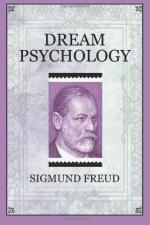bodily contours. Since “bed and board”
(mensa et thorus) constitute marriage, the
former are often put for the latter in the dream, and
as far as practicable the sexual presentation complex
is transposed to the eating complex. Of articles
of dress the woman’s hat may frequently be definitely
interpreted as the male genital. In dreams of
men one often finds the cravat as a symbol for the
penis; this indeed is not only because cravats hang
down long, and are characteristic of the man, but
also because one can select them at pleasure, a freedom
which is prohibited by nature in the original of the
symbol. Persons who make use of this symbol in
the dream are very extravagant with cravats, and possess
regular collections of them. All complicated machines
and apparatus in dream are very probably genitals,
in the description of which dream symbolism shows
itself to be as tireless as the activity of wit.
Likewise many landscapes in dreams, especially with
bridges or with wooded mountains, can be readily recognized
as descriptions of the genitals. Finally where
one finds incomprehensible neologisms one may think
of combinations made up of components having a sexual
significance. Children also in the dream often
signify the genitals, as men and women are in the
habit of fondly referring to their genital organ as
their “little one.” As a very recent
symbol of the male genital may be mentioned the flying
machine, utilization of which is justified by its
relation to flying as well as occasionally by its form.
To play with a little child or to beat a little one
is often the dream’s representation of onanism.
A number of other symbols, in part not sufficiently
verified are given by Stekel, who illustrates them
with examples. Right and left, according to him,
are to be conceived in the dream in an ethical sense.
“The right way always signifies the road to
righteousness, the left the one to crime. Thus
the left may signify homosexuality, incest, and perversion,
while the right signifies marriage, relations with
a prostitute, &c. The meaning is always determined
by the individual moral view-point of the dreamer.”
Relatives in the dream generally play the role of
genitals. Not to be able to catch up with a wagon
is interpreted by Stekel as regret not to be able
to come up to a difference in age. Baggage with
which one travels is the burden of sin by which one
is oppressed. Also numbers, which frequently
occur in the dream, are assigned by Stekel a fixed
symbolical meaning, but these interpretations seem
neither sufficiently verified nor of general validity,
although the interpretation in individual cases can
generally be recognized as probable. In a recently
published book by W. Stekel, Die Sprache des Traumes,
which I was unable to utilize, there is a list of
the most common sexual symbols, the object of which
is to prove that all sexual symbols can be bisexually
used. He states: “Is there a symbol
which (if in any way permitted by the phantasy) may




